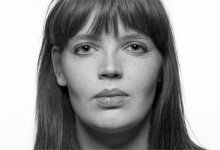Is it possible to write haiku in a country with only one season?

‘And what about the feeling that haiku, with its tendency to gaze at the pastoral – a drop of dew, a mountain, a firefly – requires a kind of distance if not a renunciation of terrifying Israeli reality?’
A few hot Fridays ago, 40 women and men sat with their eyes closed and meditated to banish their thoughts, in preparation for a haiku workshop. The people around me seemed tranquil, but I couldn’t stop thinking about the black sandals I’d bought the day before and which I’d been asked to leave on the mat at the entrance, unprotected.
The ones who endangered my new sandals are the workshop leaders, Zen teacher Yuval Ido Tal and poet Alex Ben-Ari, whose new book Korat Hasha’ar, was published this fall by Mossad Bialik. The haiku anthology is an essential part of a surprising Hebrew trend based on the Japanese verse form, including books of original and translated haiku, a blog called Missing Moon that is updated nearly every day with original Hebrew haiku, haiku workshops and evenings devoted to the writing of renga, a Japanese genre of collaborative, linked poetry.
A haiku is a miniature poem made of 17 sound units in the Japanese version, [17 syllables in English] – five to nine words – that depict a minuscule moment of illumination simply and clearly, usually while looking at nature. Haiku writers refrain from symbols and rhyme, but generally include a word indicating the season of the year in which the poem is written. Tal read a haiku by Ben-Ari from the new book: Hayarkon beh-lilah/ bin eucalyptus leh-eucalyptus/ mah-tos. (‘The Yarkon [River] at night:/ between eucalyptus and eucalyptus/ a plane’.)
At the end of the meditation session, the participants were given a task. Tal and Ben-Ari asked us to go outside and find something without looking for it, a sort of example of the mood required for haiku writing. 15 minutes was allotted to the exercise after which most of the workshop members returned to the hall holding brown disposable cups which they had found without looking for them at a kiosk. One person, who’d actually found an avocado sandwich, said that her partner had brought it for her without having been asked, although she might have been responsible, because she had told him that she was hungry before she left home. Is it really possible to find something without looking for it, she wondered. Tal smiled and bowed a small bow and read a haiku by the noted 18th-century Japanese poet Issa: ‘Now that my storehouse/ has burned down, nothing/ conceals the moon’ [English translation by Yoel Hoffmann] . . . Ben-Ari read a portion of Hoffmann’s classic introduction to the haiku anthology, Japanese Death Poems [available in both English and Hebrew editions].
[ . . . ]
One of things you understand immediately when preparing a story about haiku is that there is nothing haiku poets are more wary about than explaining them. The main reason for this distance from interpretation is the historical allegiance of the Japanese haiku poets to Zen. The noted Zen teacher Shunryu Suzuki asked his students to take the toad as an example. The toad, like a new Zen monk, sits. Unlike the new monk, he doesn’t think that sitting is anything special. The toad doesn’t know what Zen and sitting are. He simply sits and this is Zen. The figure of a toad stars, of course, in many Japanese haiku (although I didn’t find one Hebrew poem featuring a frog).
[ . . . ]
For me, one of the wonderful things about haiku is its basic approach: it is possible to find and extract poetry from all the phenomena in the world, if you’ll just look attentively. In effect, the intuitive dimension creates poetry that practically imposes itself upon the writer when she encounters the world. In my conversations with Israeli writers of haiku, a concern arose that this attempt to capture momentary beauty in words constitutes a disturbance, a sort of betrayal. This claim surprised each time I heard it, since I believe that the expression of nature, its hidden beauty, is in fact assisted by these poets, without whose consciousness it would remain mute and isolated.
‘I don’t know Japanese’, Ben-Ari told me when I asked him after the workshop had ended. ‘I came to haiku, like most Hebrew writers of it, I imagine, via Yoel Hoffmann’s anthology. I remember that I read it as a teenager and it amazed me. I was stirred by its precision. I gulped down the little there was in Hebrew . . . Yoel Hoffmann and Jacob Raz . . . and from there I continued to English’.
Q: Do you feel that that fact that most of the Hebrew writers of haiku – Liat Kaplan, Dror Burstein – don’t know Japanese, affects your poetry?
A: There is something secular and liberated in Hebrew haiku. That is, the original haiku is quite secular, it sanctifies this world, its concreteness, but Japan is immersed in Buddhism, Zen, a cultural tradition that we don’t have. This freedom has a positive aspect. For example, the convention that haiku must always include a word representing the season of the year in which it is written. It has over the centuries led to the development in Japan of a broad vocabulary of images of seasons, such as flowering peach blossoms for spring, distinctions that don’t hold in Israel (where it is always summer more or less) or aren’t culturally relevant here. In Hebrew we start from the beginning. What’s a word for summer? Watermelon? Or perhaps, sandals?
Liat Kaplan, the editor of Ben-Ari’s anthology, joined us. Kaplan’s 2001 volume Zeh Zeh (It it) is apparently the first book of haiku written in Hebrew, although preceded a bit by Roy Chicky Arad’s Hakushi (The black) – part novel and part series of haiku. In 2016 she will release a new volume of haiku, Kaan Betokh Kaan (Here inside here). She, too, is not a Japanese speaker and emphasizes that haiku isn’t a matter of language but of spirit. She, too, like Ben-Ari, encountered haiku through Hebrew translations by Yoel Hoffmann and Jacob Raz.
Q: Do either of you have an explanation for the sudden awakening of haiku in Hebrew? Could it be connected to Twitter and Facebook, to the fact that people are more used to reading short texts?
Ben-Ari: From the sociological aspect, there are more people interested in Buddhism than there were 20 and 30 years ago . . .
Kaplan: I don’t think that it is linked to Facebook or New Age [trends]. In both, the emphasis is on the self. In New Age, people are motivated to improve themselves, as consumers. This is very different from the spirit of haiku, in which one is to cancel the ego and to look past it.
Q: In the workshop, you spoke about haiku as intuitive poetry, a poetic response to a small and mundane illumination that simply emerges. This is different from the way we usually think about literary writing – a Sisyphean effort in the face of the blank page. How did you approach the writing of haiku?
Kaplan: One doesn’t approach it. I don’t sit at the computer and say, ‘Today we’ll write haiku’. For me, it’s a way of life, a daily practice, a situation of attentiveness where I’m located, or strive to be located. I write haiku all the time; I have thousands of poems. Most of them I don’t publish.
Q: Is it possible to say that a haiku written intuitively, with complete ease, requires a lifetime of preparation, like a single cashew growing on a shrub?
Kaplan: I think cashews grow on trees and not bushes.
Q: I made that up.
Ben-Ari: My plan was to publish one book of haiku at age 70. To see which poems survived the years and different stages of my life and publish only them. But there’s cultural significance, sorry if this term sounds terrible, in a book of Hebrew haiku appearing now. I’m glad that, along with the anthology, a lot of other things are happening: the blog; new translations of classic and modern haiku by Eitan Bolokan; Dror Burstein’s book of haiku, about to be published; and Roy Chicky Arad’s Airplane Carrier, which contains good haiku; and Liat’s book as well.
Burstein's first volume of haiku, Eleh Keh-regah Hi (My life at this moment), is about to be published.
[ . . . ]
Q: As a novelist, what attracts you to write haiku?
Burstein: Concentration and precision. Minuteness. The fact that you can take the poem with you everywhere, think about it again and again, dedicate weeks to the placement of one word. The truth is that I am undergoing a significant process now with regard to writing. I don’t really see how I can continue to write novels. There’s no way to preserve the level of acuity and tension that exists in one haiku.
[ . . . ]
Q: And what about the feeling that haiku, with its tendency to gaze at the pastoral – a drop of dew, a mountain, a firefly – requires a kind of distance if not a renunciation of terrifying Israeli reality?
Burstein: I don’t understand the feeling that it’s more important to write about the horrifying things that happen here. It may sound a little simple, and I know that a bit of this is required to write haiku, but I feel impelled toward haiku, to its humor, the way it disturbs definitions and borders we see as solid, in an Israeli context. I truly believe that if one of the people who set fire to the house in the [Palestinian] village of Duma [in the West Bank in July 2015, which led to the deaths of three family members and the severe wounding of the fourth] had been exposed to haiku, and read and understood it, he would not have been able to commit the act he did.
[ . . . ]





